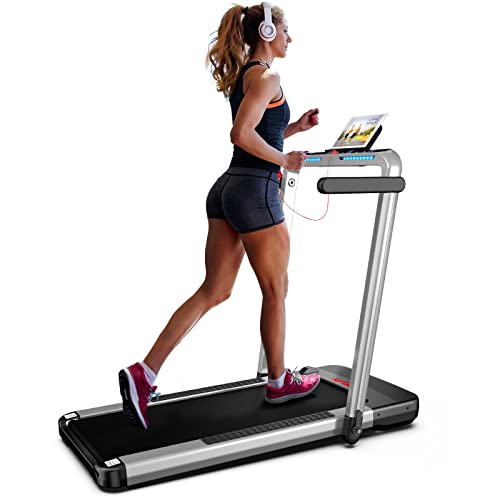
The Treadmill Machine: An Educational Guide to Your Fitness Journey
The Treadmill Compact machine has ended up being a vital tool in modern fitness programs. Whether one is an experienced athlete or a beginner trying to get into shape, a treadmill provides a convenient and efficient way to achieve physical fitness objectives. This article will explore the various elements of treadmill machines, their advantages, different types offered, and standards for efficient use.
Advantages of Using a Treadmill
Treadmills use numerous physical and psychological health advantages that contribute to total well-being. Some key benefits include:
- Cardiovascular Health: Regular use of a treadmill assists in improving heart health by strengthening the heart muscles and improving flow.
- Weight reduction: By taking part in constant cardiovascular exercises, individuals can burn significant calories, assisting in weight loss and management.
- Joint-Friendly Exercise: Treadmills supply a regulated environment that enables users to adjust speeds and slopes, making it easier on the joints than working on difficult surface areas.
- Convenience: Treadmills are specifically beneficial for those who reside in areas with negative weather conditions, as they can be used indoors year-round.
- Customizable Workouts: Many modern-day treadmills come geared up with programs and features that enable users to personalize their workouts for varying strength levels.
Health Benefits Overview
| Benefit | Description |
|---|---|
| Cardiovascular Improvement | Strengthens the heart, improving overall circulation and endurance. |
| Weight Management | Effective calorie burning resulting in weight-loss. |
| Injury Prevention | Reduced danger of injury due to adjustable surface areas and regulated environments. |
| Motivation and Consistency | Provides an indoor alternative that motivates regular exercise despite weather conditions. |
| Boosted Mood | Routine workout adds to the release of endorphins, boosting mental well-being. |
Kinds Of Treadmill Machines
While treadmills may seem straightforward, various types cater to various requirements and preferences. Here are the main classifications:
Manual Treadmills: These require no power and are moved by the user's effort. They often use up less space and are quieter however can provide a steeper knowing curve for beginners.
Electric or Motorized Treadmills: The most common type, they include automatic programs for speed and slope. They are typically more versatile but need electrical power to run.
Folding Treadmills: Designed for those with minimal area, folding treadmills can be collapsed and saved away when not in usage, making them ideal for little apartments.
Slope Treadmills: These machines use the ability to raise the incline, mimicing hill runs for a more effective workout.
Industrial Treadmills: Built for heavy usage, these machines are typically found in gyms and gym and feature a range of functions and durability.
Comparison of Treadmill Types
| Type | Power Source | Best For | Space Considerations |
|---|---|---|---|
| Handbook | None | Beginners, budget-conscious users | Low |
| Electric | Plug-in | Differed intensity exercises | Medium to High |
| Folding | Plug-in | Minimal area users | Low |
| Slope | Plug-in | Intense cardio and strength | Medium to High |
| Business | Plug-in | Regular gym usage | High |
Tips for Effective Treadmill Use
To optimize the benefits of a treadmill regimen, here are numerous pointers to consider:
- Warm-Up: Start every workout with a 5-10 minute warm-up at a sluggish speed to prepare the body.
- Posture: Maintain an upright posture, keeping shoulders back and direct to prevent pressure and injury.
- Period Training: Incorporate various speeds during exercises (high-interval training) to enhance cardiovascular fitness and burn calories.
- Use Inclines: To even more improve workouts, include slope alternatives to imitate hill running, which constructs strength in the legs.
- Stay Hydrated: Keep a water bottle nearby, ensuring to consume in the past, during, and after workouts to remain hydrated.
Advised Treadmill Workouts
- Newbie's Walk: Start at a moderate rate for 20-30 minutes, gradually including speed as convenience increases.
- Hill Intervals: Alternate between slope and flat surface areas, sprinting uphill for 1 minute followed by walking for 2 minutes.
- Long-Distance Run: Target a constant rate for an extended duration (40-60 minutes), focusing on endurance.
- Speed Training: Change speeds every minute, beginning with a light jog to brief bursts of running to improve speed and cardiovascular health.
FAQs
Q1: How frequently should I utilize a treadmill for reliable outcomes?
A1: It is normally suggested to use a treadmill a minimum of three times weekly for 30-60 minutes to see considerable outcomes.
Q2: Can I lose weight using a treadmill?
A2: Yes, with a mix of regular exercise, a balanced diet plan, and portion control, using a treadmill can contribute significantly to weight loss.
Q3: Do I need to warm-up before using the treadmill?
A3: Yes, heating up is vital to prepare your body, reduce the threat of injury, and enhance exercise performance.
Q4: Is running on a treadmill as efficient as running outdoors?
A4: Both have benefits, but a treadmill permits for controlled environments, avoiding weather-related disruptions, and might have less effect on the joints.
Q5: Can a treadmill assist with bodybuilding?
A5: While mainly a cardiovascular tool, changing inclines can assist engage and strengthen specific leg muscles.
Treadmill machines are flexible and can be an integral part of a physical fitness journey. By understanding the various types, advantages, and efficient usage techniques, individuals can use the complete capacity of this devices. Whether going for improved cardio health, weight management, or enhanced mental well-being, a treadmill acts as a trustworthy buddy on the roadway to fitness.
